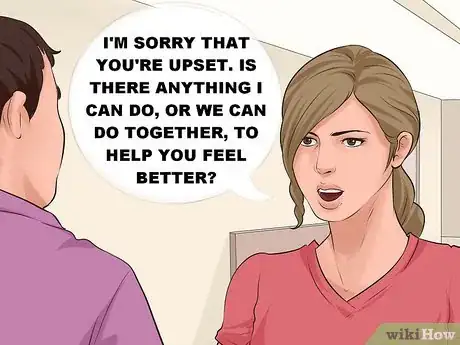This article was co-authored by Trudi Griffin, LPC, MS. Trudi Griffin is a Licensed Professional Counselor in Wisconsin specializing in Addictions and Mental Health. She provides therapy to people who struggle with addictions, mental health, and trauma in community health settings and private practice. She received her MS in Clinical Mental Health Counseling from Marquette University in 2011.
wikiHow marks an article as reader-approved once it receives enough positive feedback. In this case, 80% of readers who voted found the article helpful, earning it our reader-approved status.
This article has been viewed 71,847 times.
Conflict can result when people have differences in opinions, beliefs, and thinking. It can occur with coworkers and supervisors in the workplace and with family and friends in your personal life. Conflict is an uncomfortable yet natural part of life. However, when conflict is not dealt with effectively, it can result in personal attacks, deadlock, and unproductive behavior. Learning how to successfully address conflict is a worthwhile endeavor that can benefit you for a lifetime.
Steps
Choosing a Healthy Response
-
1Take a break if you need one. It is important to get your emotions under control before you respond to a conflict. Otherwise, you may end up overreacting, saying something out of anger, or responding in a frightening way.[1] Try excusing yourself for a few minutes, if possible, and use the time to calm yourself down.
- For example, you could go for a quick walk around the neighborhood to give you a chance to process your thoughts. Or, you could go into another room and write down what you are thinking and feeling.
-
2Accept that your feelings are simply your own. There are a range of emotions that you can experience when facing conflict, such as anger, fear, despair, and confusion. However, the person who you are in conflict with may not be feeling the same things. As a result, the emotional differences might leave your feeling threatened or confused. [2]Advertisement
-
3Pay attention to your inner thoughts. Your inner thoughts are the thoughts than run through your mind when facing a conflict, which you are normally made aware of through self-talk. [3] Sometimes you may have conflicting inner thoughts. Though no one can hear what you are thinking, your internal dialogue can help you to understand your emotional and physical responses.
- For example, if someone were to cut in front of you while standing in line, you might think, “Who does he think he is cutting in front of me like that,” or “I don’t think he recognized that I was standing here before him.”
- As a result of these conflicting inner thoughts, you might exhibit a positive emotional response by politely saying, “Excuse me, but I believe I was waiting in line before you,” or demonstrate a negative physical response by forcefully placing yourself in front of the person.
-
4Manage your physical response to conflict. You need to pay attention to the physical reactions that your body has when facing conflict, as your physical responses play a prominent role in how effective you are in addressing the conflict.[4] Physical responses to conflict include increased stress, heartbeat, and sweat; feeling physically tense; or having shallow or accelerated breathing. [5]
- You can control your physical reactions to conflict through various stress management techniques, such as meditation, deep breathing, and exercising. Moving to a more relaxing place is another good way to manage negative physical responses.[6]
-
5Listen to the other person’s side. Being willing to listen is an important part of responding to a conflict. By listening closely to what the other person has to say you will get a better understanding of his or her perspective and you will also be more likely to be heard when it is your turn to speak.[7]
- Try telling the person something like, “I really want to understand your perspective, so I am willing to listen if you would like to talk.”
- Make sure that there are no distractions while you are listening. Put away your cell phone, turn off the TV, and choose a quiet place.
-
6Stay focused on the present moment. When you have a conflict with someone, it might be tempting to bring up past problems and use them as ammo against the person. However, this can make a conflict worse. Instead, stay focused on solving the problem at hand.[8]
- If you start reflecting on past problems, remind yourself that those things are in the past. Your goal is to solve the current conflict.
-
7Talk to someone about what happened. Discussing the conflict with a friend or family member may help you to put things into perspective. Talking about how the conflict made you feel is also a good way to vent some of your anger over the situation.
- Try calling up a trusted friend or family member before you respond to the situation.
Using Different Conflict Resolution Styles
-
1Use accommodation to build cooperation. Accommodation is a way of responding to conflict in which the other person gets, more or less, what they want. An accommodator is often a team player who will make personal sacrifices to keep a positive and peaceful environment.[9]
- If you choose to respond with accommodation, be sure that you are not sacrificing too much. This could cause you to feel resentful and may lead to other problems down the road.
- You could show accommodation by saying, “I know you had plans to hang out with your friends instead of taking our son to karate. It’s fine for this time; I can take him. However, I’d like you to plan to take him next week.”
-
2Try avoidance if you need more time to gather more information. Avoidance is responding to conflict by postponing or withdrawing from the problem for a while. An avoider doesn’t like conflict and typically prefers not to interact with aggressive individuals.[10] Avoidance can be useful if you are not totally sure about all of the details of the conflict.
- If you choose to use avoidance to handle a conflict, make sure you aren’t avoiding the conflict for so long that the problem becomes worse. In addition, be sure to still demonstrate professionalism by fulfilling professional duties like returning phone calls, responding to emails, and showing up for meetings.
- Here’s an example of using avoidance. You’re a school teacher and an angry parent has called you about his daughter being accused of bullying another child. He doesn’t believe the accusations against his child, and this is the first time you’ve heard about the problem. When you call the parent you say, “I understand why you would be upset. Let me talk to your child and the other student this morning, and I will give you a call later this afternoon.” This gives you more time to gather information.
-
3Collaborate to increase commitment. Collaboration involves taking an assertive and cooperative approach to resolve conflict. The collaborator strives to work together with others in resolving conflict so that it’s a win-win for everyone involved.[11]
- When using collaboration, make sure you have established clear expectations and are aware of the appropriate boundaries and deadlines necessary to reach an acceptable resolution. Also, be careful not to overanalyze a problem so you can avoid delays in the decision-making process.
- For example, if you are having a conflict with a coworker who favors a different approach to an assignment, then you could collaborate by saying, “Let’s sit down to discuss the options that we have. Together we can identify the best approach to this assignment.”
-
4Compromise to promote negotiation. Compromising is described as a win and lose agreement between two parties; both parties end up with some, but not all of, what they wanted.[12] The compromise looks for a quick and fair resolution to conflict so that both parties are at least partially satisfied.[13]
- When compromising, make sure you are looking at the larger picture before quickly jumping into a compromise resolution.[14] This will help you in avoiding unforeseen consequences.
- For example, as a supervisor, you might compromise with a subordinate by saying, “We need to complete this project by midnight tonight. I know you don’t want to work late today, but I don’t see how we can get it done before the end of the work day. What if you work for two extra hours today, and you can either come in two hours late or leave two hours early on tomorrow?”
References
- ↑ http://www.helpguide.org/articles/relationships/conflict-resolution-skills.htm
- ↑ https://www.ohrd.wisc.edu/home/HideATab/LeadershipManagementDevelopment/ConflictResolution/AboutConflict/ConflictResponse/tabid/229/Default.aspx
- ↑ https://www.ohrd.wisc.edu/home/HideATab/LeadershipManagementDevelopment/ConflictResolution/AboutConflict/ConflictResponse/tabid/229/Default.aspx
- ↑ https://www.ohrd.wisc.edu/home/HideATab/LeadershipManagementDevelopment/ConflictResolution/AboutConflict/ConflictResponse/tabid/229/Default.aspx
- ↑ https://www.ohrd.wisc.edu/home/HideATab/LeadershipManagementDevelopment/ConflictResolution/AboutConflict/ConflictResponse/tabid/229/Default.aspx
- ↑ https://www.ohrd.wisc.edu/home/HideATab/LeadershipManagementDevelopment/ConflictResolution/AboutConflict/ConflictResponse/tabid/229/Default.aspx
- ↑ http://www.helpguide.org/articles/relationships/conflict-resolution-skills.htm
- ↑ http://www.helpguide.org/articles/relationships/conflict-resolution-skills.htm
- ↑ http://www.jhsph.edu/research/centers-and-institutes/womens-and-childrens-health-policy-center/MCHLDS/5approaches.pdf
- ↑ http://www.jhsph.edu/research/centers-and-institutes/womens-and-childrens-health-policy-center/MCHLDS/5approaches.pdf
- ↑ http://www.jhsph.edu/research/centers-and-institutes/womens-and-childrens-health-policy-center/MCHLDS/5approaches.pdf
- ↑ http://www.mediate.com/articles/eilermanD7.cfm
- ↑ http://www.jhsph.edu/research/centers-and-institutes/womens-and-childrens-health-policy-center/MCHLDS/5approaches.pdf
- ↑ http://www.jhsph.edu/research/centers-and-institutes/womens-and-childrens-health-policy-center/MCHLDS/5approaches.pdf









































































